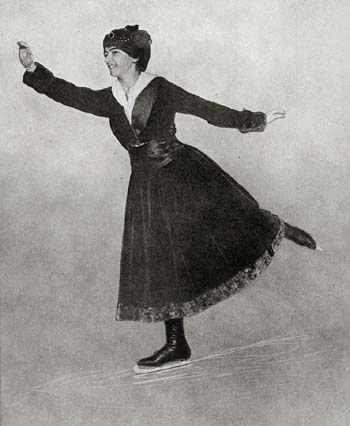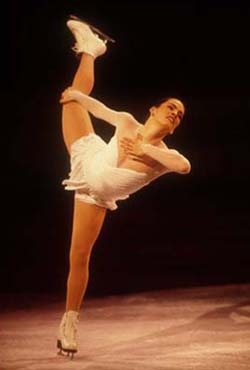 |
Women and Men in Society
Skating Champions Yesterday and Today
Marian T. Horvat, Ph.D.
The photograph below right was taken in New York on March 23, 1917, when amateurs contested the Woman's Figure Skating Championship cup. That year, Theresa Weld of Boston won.

The 1917 figure skating champion |
Her costume of wine-colored velvet trimmed with mole-skin, a small close toque (cap) to match, was one of the most appropriate and attractive of the times. Theresa Weld herself was held up as a model for women skaters.
Emily Burbank, author of Woman as Decoration, published in 1917 (Dodd, Mead & Co.), praises Theresa Weld not only for her excellent skating, but for her costume, which she judges appropriate, becoming, and stylish. We would add modest to the list of these adjectives. Who today could imagine a champion skater so decorously feminine and well-covered?
Emily Burbank made this effusive praise of her skating and outfit:
“Miss Weld combined good work with perfect form, and her edges, fronts, ins, outs, threes, double-threes, etc., etc., were a delight to the eye as she passed and re-passed in her wine-colored velvet, trimmed with mole-skin, a narrow band on the bottom of the full skirt (full to allow the required amount of leg action), deep cuffs, and a band of the same fur encircling the close velvet toque. This is reproduced as the ideal costume because, while absolutely up-to-date in line, material, color and character of fur, it follows the traditional idea as to what is appropriate and beautiful for a skating costume, regardless of epoch.
“We have seen its ancestors in many parts of Europe, year after year. Some of us recall with keen pleasure the wonderful skating in Vienna and Berlin on natural and artificial ice, invariably hung with flags and gaily lighted by night. We can see now, those German girls – some of them trim and good to look at – in costumes of sapphire blue, deep red, or green velvet, fur trimmed,—gliding swiftly across the ice, to the irresistible swing of waltz music and accompanied by flashing uniforms.
“In the German-speaking countries everyone skates: the white-bearded grandfather and the third generation going hand-in-hand on Sunday mornings to the nearest ice-pond. With them skating is a communal recreation, as beer garden concerts are. With us in America most sports are fashions, not traditions.” (pp. 134-135)
A thought crossed my mind as I read those paragraphs. It gives the lie to the bold claim – often made even in traditionalist circles – that it is absolutely necessary for women to wear slacks or shorts for certain sports such as skating, skiing, sledding, hiking, and so on. Further, the female skaters of 1917 did not freeze or catch cold because they were not wearing slacks – another pointless argument often heard today.
Then skating was not foremost a competitive sport. It was a recreation, a tradition to be enjoyed by the whole family in appropriate dress. As Emily Burbanks comments, in Vienna and Berlin “everyone skated” – the ladies and girls in their fur trimmed skirts and the grandfathers in their topcoats and hats.

The 1993 figure skating champion |
In contrast to Theresa Weld’s feminine pose and appropriate outfit in 1917, consider the photograph at left of the 1993 U.S. figure-skating champion.
Today – as you can see at left – it has become almost a demand of the sport to wear immodest skating costumes that expose the limbs of the body. What little material that exists in her costume is low-necked and tight-fitting, revealing what should be concealed. She – like the typical figure skater of our days – is completely immodest before a mixed audience. An upright Catholic parent could hardly hold her up as a model for their daughters to follow.
Further, her pose is no longer dignified and properly feminine. The new skating moves are often bold, provocative and sensual. I don’t believe it is possible for men to watch these skating events solely with the aim of judging the artistic skating skills of the badly dressed contestants. How can they not consider and judge the figures of the young women, so audaciously displayed?
I am reminded of the words of warning that Our Lady made at Fatima in the same year the first photo was taken, 1917. She told Jacinta that “certain fashions will be introduced that will gravely offend My Son.” She also told the children that more souls go to Hell because of sins of the flesh than anything else. Certainly, sports clothing and immodest positions like the ones we see today promote sins of impurity.
There is no way to justify the modern sports clothing for women skaters, acrobatics, cross-country runners, bicyclers, and so on. They are immodest – blatantly and grossly so – and good Catholics parents would do well to heed the words of Our Lady and keep them out of their own wardrobes and those of their daughters.

Posted August 21, 2009

Related Topics of Interest
 Women in Sports and Purity Women in Sports and Purity
 The Career or Mother Dilemna The Career or Mother Dilemna
 Forfeiting a Game for Principles Forfeiting a Game for Principles
 Polemic: Should Women Wear Slacks? Polemic: Should Women Wear Slacks?
 The Four Temperaments The Four Temperaments
 Questions on Fashion Questions on Fashion
 Tradition, Stagnation and Progress Tradition, Stagnation and Progress
 R-CR in the Tendencies, Ideas and Facts R-CR in the Tendencies, Ideas and Facts

Related Works of Interest
|
|
Women and Men | Cultural | Home | Books | CDs | Search | Contact Us | Donate

© 2002- Tradition in Action, Inc. All Rights Reserved
|
 |
|